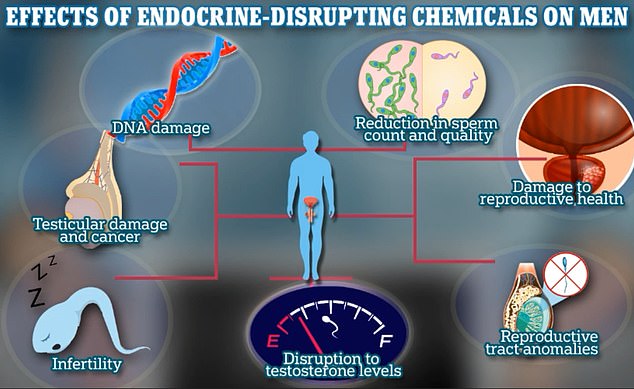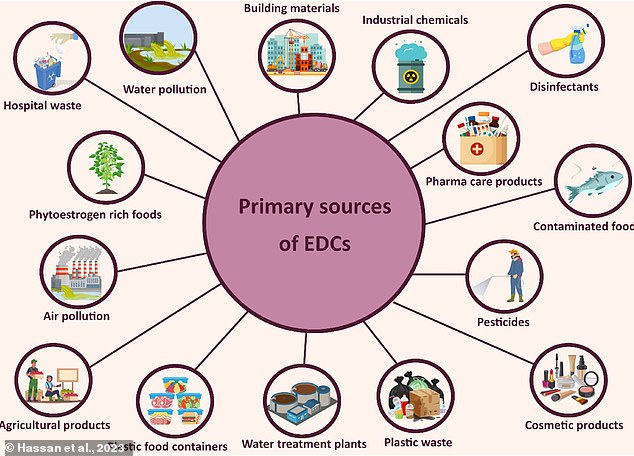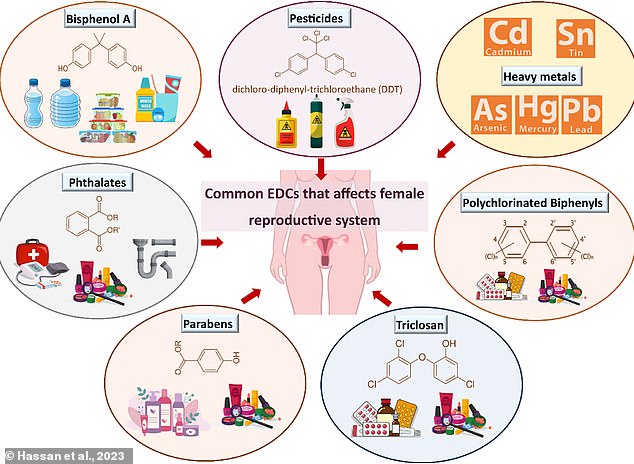Two major studies reveal devastating effect of PFAS and food additives on male and female sexual health: From sperm damage to smaller testicles, early menopause and ovary cysts
In recent years, concerns about the contaminants in our food and everyday products have made headlines due to their link to cancer.
But a growing body of research suggests the microscopic molecules also have a devastating effect on fertility and may be contributing to the American ‘baby bust’.
In two new reviews of the scientific literature, researchers from around the world looked at the impact of exposure to endocrine-disrupting chemicals (EDCs) on the reproductive health of men and women.
They found that these substances can cause infertility, genital deformities, lower sperm count and quality, early menopause and an increased risk of breast and testicular cancer.
EDCs include PFAS, but also pesticides, phenols, a group of chemicals found in toys and dental products; phthalates, a group of chemicals in food packaging; parabens, a group of chemicals used as food preservatives; and triclosan, an antimicrobial agent used in soaps and hand sanitizers.
Some effects in women of EDCs include early menopause, an increased risk of breast cancer, endometriosis, which can lead to infertility, and metabolic syndrome, which increases the risk of heart disease, stroke and diabetes.

In men, researchers looked at data from multiple animal and experimental studies and concluded that there was strong evidence of negative effects on men’s reproductive health and on exposure to EDCs.
Some primary sources of PFAS and other contaminants include plastic food containers, makeup, cleaning sprays, medications, contaminated food, and water and air pollution.
Researchers from Vietnam, India, New Zealand and the United States reviewed more than 300 sources of information, including previous experimental studies and data from national and international health monitoring databases, as well as animal studies.
In assessing the impact on women, the team looked at studies that analyzed levels and exposure to pollutants and tested and evaluated placenta, urine, blood, hormone levels and tissues.
Researchers found that exposure to Bisphenol A, or BPA, can lead to a decrease in egg development and quality and an increased risk of implantation failure, when fertilized eggs do not implant properly into the uterine lining, often resulting in pregnancy loss.
Polycystic ovarian syndrome (PCOS), which is a major contributor to infertility and a risk factor for endometrial cancer and diabetes, has also been linked to BPA exposure.
BPA is a type of plastic used to make plastic tableware, auto parts, toys, beverage containers and CDs.
Exposure to phthalates, compounds in soaps, shampoos, lubricating oils and plastic packaging was associated with a reduced risk of pregnancy and lower quality eggs.
Additional consequences for women observed in the previous studies include early menopause, an increased risk of breast cancer, endometriosis, which can lead to infertility, and metabolic syndrome, which increases the risk of heart disease, stroke and diabetes.
These harmful substances can also lead to longer menstrual cycles and premature onset of puberty, which has been linked to depression, substance abuse, sexual assault and breast cancer in adults.
The EDC group of PFAS has been linked to a shortening of a mother’s lactation period, the time frame a woman produces breast milk, and researchers found that a type of pesticide led to shortened menstrual cycles, which can affect reproduction.
During pregnancy, exposure to EDCs has been linked to maternal obesity, high blood pressure and preeclampsia, a life-threatening blood pressure condition.
Studies have also shown mixed results about exposure to EDCs and preterm birth.
Based on their results, researchers strongly advocate eating organic foods and avoiding plastic and canned foods and drinks.
Data also supports avoiding fast food, following a vegetarian diet, changing personal care products and reducing dust.
Using stainless steel or glass bottles and containers as well as cardboard packaging instead of plastic packaging and avoiding plastic cutlery and non-stick cookware will also help reduce exposure to contaminants.

Endocrine disruptors can come from many sources, including plastics, makeup, personal care products and pharmaceuticals.

Women are often exposed to EDCs in products they use every day, such as makeup, soaps, shampoos and certain medications.

PFAS is a common contaminant in many household items, from cookware to hamburger wrappers. It can remain in the environment and in human tissue for years, even decades, before being cleared
The researchers emphasize the importance of reducing exposure, especially in the period just before pregnancy and in the early stages of pregnancy.
In men, researchers looked at data from multiple animal studies and concluded that EDCs also have negative effects on men’s reproductive health.
Phenols, a large group of chemicals used in building materials, dental products, food packaging, hand sanitizers and food preservatives, have been shown in animal studies to reduce sperm count, damage DNA and alter testosterone levels, as well as lead to testicular damage.
Phthalates, a group of chemicals found in personal care products, dietary supplements, medications and home furnishings, have shown in animal studies to cause malformations of the male reproductive tract, as well as adverse reproductive effects, including reduced testicular size. malformation of the external genitalia and decreased sperm production.
Sperm quality is the most common cause of male infertility, accounting for 40 percent of cases, and poor testicular function is also associated with a higher risk of chronic disease and mortality.
Pesticides, harmful substances intended to prevent, destroy, repel, or mitigate pests, are widely used in agriculture, and the industry is responsible for 90 percent of total pesticide use.
Surveillance data from across the US shows that almost all Americans have detectable levels of pesticides in their urine or blood.
Diet, particularly the consumption of fruits and vegetables, is the leading source of pesticide exposure for the general population – and the Food and Drug Administration has shown that a significant portion of domestic fruits and vegetables contain detectable pesticide residues or that residue levels exceed government figures. standards.
There is strong experimental evidence in animal studies, researchers say, showing that pesticide exposure disrupts hormones, lowers sperm count and motility, reduces testosterone and changes sperm DNA.
As with the female studies, researchers advocate organic diets.
They also concluded that additional studies, particularly on PFAS and air pollution, are needed to investigate the relationship between these EDCs and men’s reproductive health.
EDCs are compounds that disrupt the function of the endocrine system, which is responsible for regulating the body’s hormones and all biological processes from conception through old age, including the development of the brain and nervous system and the growth and function of the reproductive system .
The ovaries and testes, as well as the pituitary gland, thyroid and adrenal glands are important components of the endocrine system.
A type of EDC, PFAS or per- and polyfluoroalkyl substances are a group of synthetic chemicals present in food packaging, clothing and thousands of other products in the US.
Because of their ubiquity, they leach into soil, drinking water, air and food, exposing Americans to the toxins almost everywhere.
They are considered ‘forever chemicals’ because they do not break down in the environment or the human body and have been linked to birth defects and an increased risk of a range of cancers.
Apart from the burden these medical problems will have on an already stressed healthcare sector, the decline in fertility will exacerbate the fertility crisis across the country.
Fertility rates in the United States are at historic lows and show no signs of reversing. Experts warn that a continued decline in births is leaving the US facing an economic crisis.
The studies have been published in the journals Environmental Research and Fertility and Sterility.
